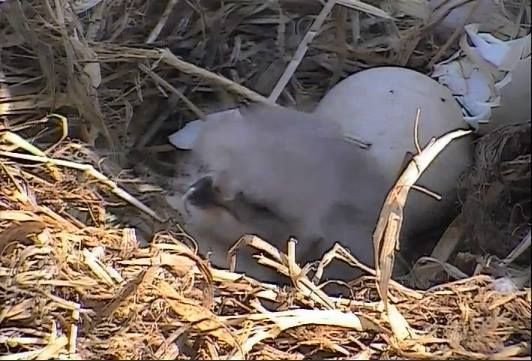First Decorah Eagle Egg D18 Hatching Footage: Will The Rest Of The Eggs Survive? [VIDEO]

Some thought the Decorah eagle eggs were doomed after Iowa experienced an unusually cold winter, but hatchling D18 just proved them wrong. The most eggciting news of the season came Wednesday morning, when the eaglet emerged from its shell at 9:22 local time. The pipping began around noon Tuesday and nearly just on schedule, a baby eagle emerged the next morning.
The Raptors Research Project, which specializes in the preservation of birds of prey, set up live cams near the birds’ nests in Decorah, Iowa, to catch them laying their eggs and, of course, the moment the chicks emerge from their shells. On Wednesday the RRP took to their Facebook page, which has nearly 100,000 likes, to share the great news: D18 has arrived and is the first eaglet of the season.
The “D” seems to stand for Decorah and “18” is the “total number of young produced on this territory” so far, the RPP explained in the post. Pretty thrilling news, considering the eggs had to withstand heavy snow, -40 degrees Fahrenheit wind chills, direct temperatures of -20 degrees Fahrenheit and drenching rains.
For those who didn’t get to see D18 emerge from its shell, the RRP provided multiple YouTube clips. In the first one, the mother gets up from sitting on the eggs around the 40-second mark and then flies away once the eaglet has broken half of the shell. Around the 2-minute mark, the other parent sits back on the nest.
The second video shows a closeup view of the eggs around the 2-minute mark, and the chick can be seen emerging from its shell on the 4:30-minute mark. The third video starts with a closeup of the eagle sitting on the nest and doesn’t show the eaglet hatching until the 3:30-minute mark. The chick looks like it’s trying to move around before the parent eagle sits back on top of the nest. The fourth video claims to have footage of a “little wing” popping out of the shell. The final video shows the chick moving around and breathing around the 4:20-minute mark before the parent eagle ultimately covers up the nest again. Check it out below:
Follow me on Twitter @mariamzzarella
© Copyright IBTimes 2024. All rights reserved.








